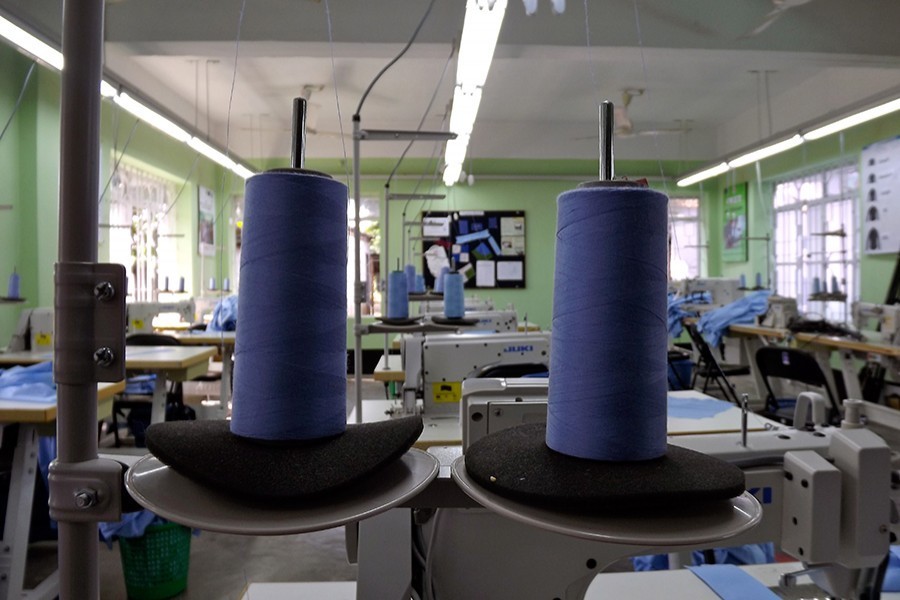
Published :
Updated :

Apparel industry is gasping for sufficient workers to operate at full capacity and grab work orders pouring in here in recent months, according to industry people.
They attribute this dearth of workforce to Covid-19 fallout, migration of skilled workers abroad, halt to helper recruitment and inadequate training.
US-China trade war, buyers' search for alternatives, factory closure in Vietnam and Cambodia for Covid-19, and Myanmar issues contribute to the last few months' export earnings in Bangladesh, they say.
But many factories cannot expand its capacity despite orders mainly for worker shortages, they noted.
Shahin Mohammad, senior general manager at Maasco Group, says they are expanding following huge work orders but are not getting workers, especially the skilled ones, as per requirements.
"Although we've many orders, we can't expand due to a shortage of workers," he told the FE on Monday.
Bangladesh Knitwear Manufacturers and Exporters Association (BKMEA) vice-president Fazlee Shamim Ehsan said they would exceed export earnings target of this fiscal but could not fully reap the benefits.
"Plenty of garment work orders are coming here in Bangladesh, but we can't grab those mainly because of a shortage of workers," he noted.
Snowtex Outwear Ltd managing director SM Khaled also spoke about a skilled worker crisis.
Snowtex fired 80 per cent of some 4,000 workers hired last year. It first employed them as helpers for three months and later provided one-month in-house training to operators' post.
Mr Khaled says his company has the capacity to train hundreds of workers.
Chorka Textile Ltd (CTL), a sister concern of the Pran-RFL conglomerate, wants to start full-fledged double-shift production at its existing capacity to meet the growing demand for knitwear, especially lingerie.
It introduces double shifts in departments like cutting and finishing, but could not fully introduce the same in other department for manpower crisis.
"One of the main challenges to enhance the production capacity is the availability of required workers," Ahsan Khan Chowdhury, chairman and chief executive officer of Pran-RFL Group, said recently.
The CTL has 7,000 workers and an additional 7,000 would be needed for double-shift production, he said, highlighting both skilled and unskilled worker crisis.
Local RMG items, especially lingerie, are in great demand globally and orders are coming here.
About manpower crisis, BKMEA leader Mr Ehsan says one reason is that previously garment units employed one helper or two in each machine with an operator.
This is not currently being done mainly because of the last wage hike in 2018, he adds.
Since the onslaught of Covid-19 in 2020, Mr Ehsan noted, many workers went back to their village homes and did not return as they engaged in other jobs.
He, however, differs with others on the percentage of workers who did not return to Dhaka and its adjoining industrial belts, saying the number is not that high.
Another reason, according to Mr Ehsan, is the lack of required training centres, seeking both government and entrepreneur-level measures to this end.
Talking to the FE, BKMEA executive president Mohammad Hatem said all government training institutes across the country should open and provide industry-focused training in tandem with allied trade bodies.
On the ongoing SEIP project, stakeholders say this is not enough to meet the industry's needs while the duration is too short to get proper knowledge of machine work.
When asked, Bangladesh Garment Manufacturers and Exporters Association (BGMEA) president Faruque Hassan also attested to a shortage of workers in the industry.
Citing the era of the 4th industrial revolution, he recognised the need to focus on adoption of technology and skills development of workers and employees.
Bangladesh National Garment Employees League president Sirajul Islam Rony said hundreds of terminated workers went to villages during Covid-19 and did not return as many switched to other professions.
Besides, many skilled workers have gone abroad, especially to Jordan and Mauritius, he told the FE.
Most importantly, uncertainty over service benefits after long years of job in garment sector discourages workers to join the industry, he argues.
Workers do not get post-retirement benefits or they have to fight a legal battle for settlement, he alleges.
According to Mapped in Bangladesh (MiB), the male-female worker ratio now stands at 42:58 in the industry that earned $31.45 billion in the last fiscal year.
It reflects that women participation in the sector is gradually declining from 80 per cent.
MiB, an RMG digital mapping project of Brac University supported by development partners and backed by the trade bodies in the sector, shows 3,500 RMG factories countrywide.
Of them, 582 are not members of any of the two trade bodies-BGMEA and BKMEA.
An estimated 2.7-million workers are employed in 3,500 export-oriented garment factories, disclosed MiB data.
munni_fe@yahoo.com


 For all latest news, follow The Financial Express Google News channel.
For all latest news, follow The Financial Express Google News channel.